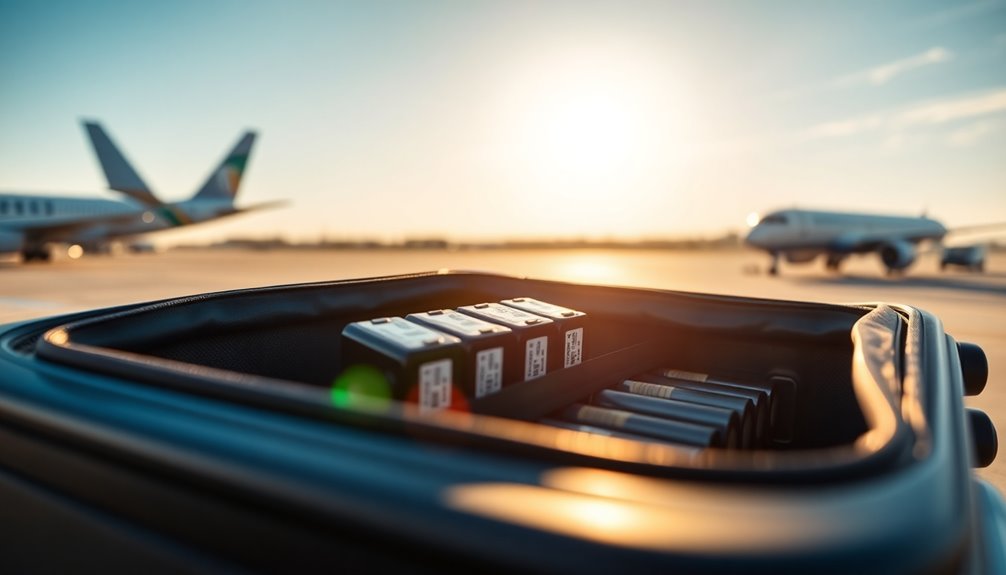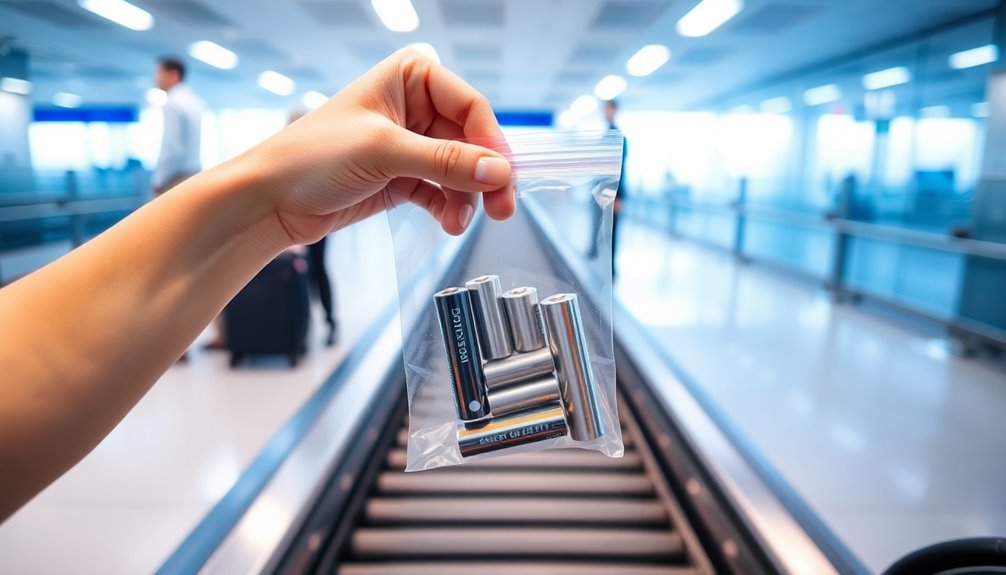Yes, lithium batteries are allowed on planes, but you need to follow specific safety guidelines. Always pack lithium batteries in your carry-on luggage, as they're prohibited in checked bags. Batteries under 100 watt-hours don't require extra approval, while those between 100-160 watt-hours need airline consent. Make certain spare batteries have protective cases to prevent short circuits. It's crucial to cover terminals with tape and use sturdy packaging. Staying informed about your airline's specific policies is important for smooth travel. Keep these tips in mind, and you'll enhance your safety on board. There's plenty more to ponder to guarantee a hassle-free journey!
Key Takeaways
- Lithium batteries must be carried in carry-on luggage, not checked baggage, to minimize fire risks during flights.
- Batteries under 100 watt-hours are allowed; those between 100-160 watt-hours require airline approval.
- Spare batteries must be in protective cases to prevent short circuits and should have terminals taped.
- Always check specific airline policies and international regulations regarding lithium batteries before traveling.
- In case of overheating or smoke, notify cabin crew immediately and do not attempt to retrieve the device.
Understanding Lithium Battery Risks
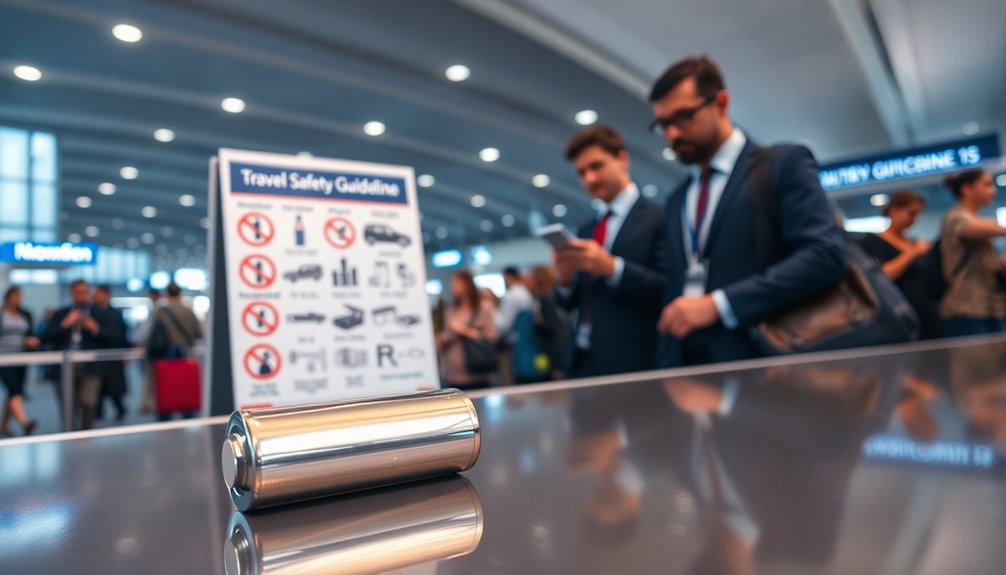
When you travel with devices powered by lithium batteries, it's crucial to understand the potential risks they pose.
These batteries can present a fire risk due to thermal runaway from overheating, physical damage, or short-circuiting. Since 2006, incidents involving lithium battery fires in aviation led to strict FAA regulations regarding their transport.
Spare batteries aren't allowed in checked luggage and must be in your carry-on baggage, properly protected to prevent damage. For added travel safety, verify your lithium-ion batteries are under 100 watt-hours; those between 100-160 watt-hours need airline approval.
Always stay vigilant for signs of overheating during your flight, as reporting any issues to cabin crew immediately can help mitigate fire risks associated with lithium batteries.
Regulations for Carry-On Batteries
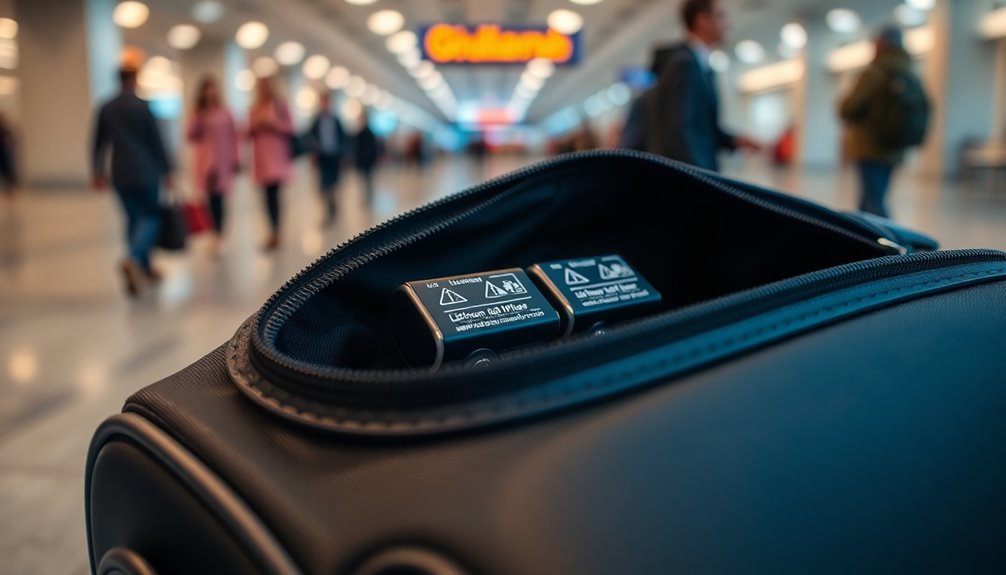
While traveling, it's essential to know the regulations for carrying lithium batteries to guarantee a safe journey. Here's what you need to keep in mind:
- Installed lithium-ion batteries in your devices are fine in carry-on luggage.
- Spare batteries must be stored in protective cases to prevent short circuits.
- Batteries with a watt-hour rating of less than 100 Wh don't need special airline permission.
Make certain you tape the terminals of spare batteries to reduce the risk of accidental activation.
Remember, portable chargers and vaping devices must also go in your carry-on bags.
Following these transportation security guidelines guarantees you won't encounter issues at the airport and keeps everyone safe during your travels.
Guidelines for Checked Luggage
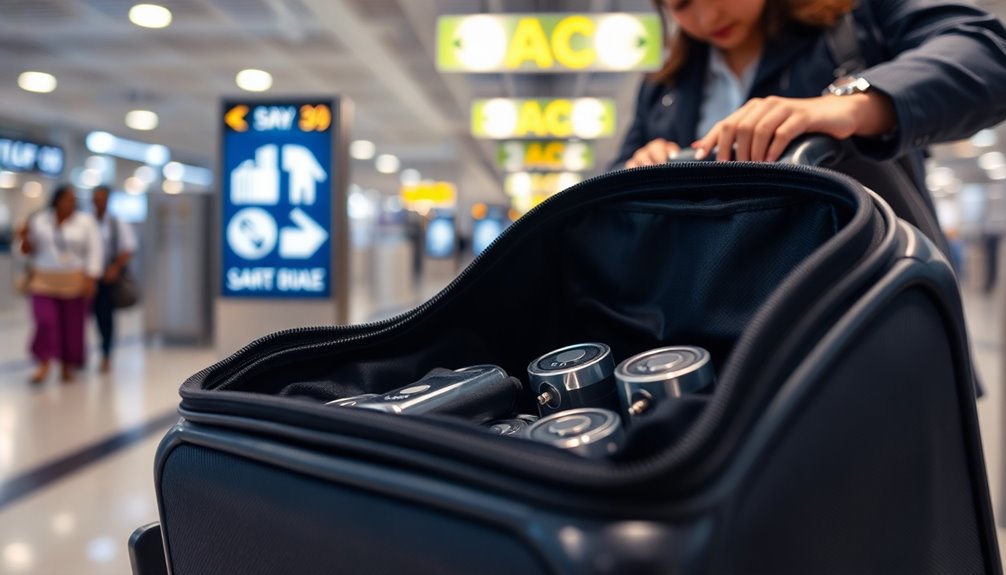
To guarantee a safe journey, you should follow specific guidelines for packing lithium batteries in your checked luggage.
The FAA regulations allow lithium batteries only if they're installed in devices like laptops or cameras to minimize fire hazards. Always make certain these devices are powered off completely before checking in as a safety precaution against accidental activation.
Loose batteries are strictly prohibited in checked baggage and must go in your carry-on luggage. If covering battery terminals with tape isn't possible, keep the batteries installed in the devices.
Also, check with your airline regarding watt-hour ratings, as batteries over 100 watt-hours may require prior approval.
Following these guidelines will help you travel safely with your lithium batteries.
Safe Packing Practices
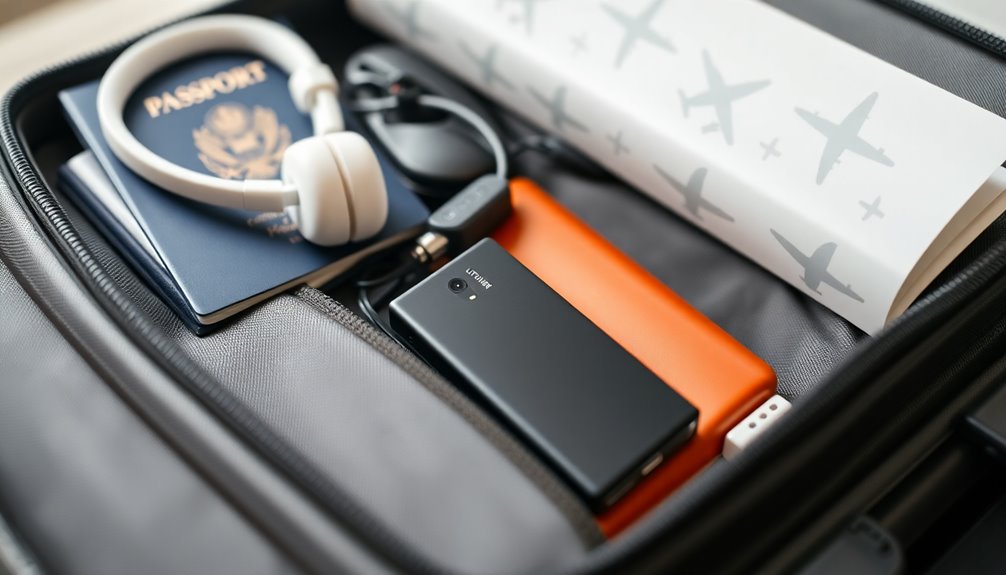
When packing lithium batteries, always use the original packaging to guarantee they're secure and protected.
To prevent short circuits, tape the terminals of any loose batteries and consider weight minimization strategies for your luggage.
Original Packaging Use
Using the original packaging for lithium batteries is essential for safe transport on planes. This packaging often includes built-in safety features that help prevent short circuits and protect from physical damage during your travels.
If you don't have the original packaging, secure Ziploc bags can serve as a substitute.
To guarantee your batteries are safe, consider these practices:
- Taping battery terminals to minimize the risk of accidental activation.
- Keeping batteries separated to avoid contact with metal objects.
- Using sturdy packaging to enhance passenger safety and prevent incidents.
Short Circuit Prevention
Packing lithium batteries safely goes beyond just using original packaging.
To prevent short circuiting, always store loose lithium batteries in protective pouches or tape their terminals with clear tape. This minimizes the risk of accidental activation and keeps them from touching any metal objects.
When carrying spare lithium batteries, use separate plastic cases or bags to avoid direct contact with other devices that might bridge terminals.
Never take damaged, defective, or recalled lithium batteries, as they increase the risk of thermal runaway incidents.
Familiarize yourself with airline-specific safety guidelines regarding lithium batteries to enhance your travel experience.
Weight Minimization Strategies
To guarantee a smooth travel experience, you should focus on minimizing the weight of your carry-on items, especially when it comes to lithium batteries.
Here are some effective weight minimization strategies:
- Limit spare batteries to only essentials to reduce weight and fire risk.
- Use original packaging or padded pouches to secure batteries, which are lighter than bulky cases.
- Consider multi-functional devices, like a smartphone that also serves as a camera, to cut down on the total number of batteries needed.
Before you travel, keep your devices fully charged or completely powered off.
This way, you won't need extra charging equipment, further enhancing safety and keeping your carry-on light.
Emergency Procedures During Flights

In the event of a lithium battery emergency during a flight, knowing the proper procedures can make all the difference. Here's what to remember:
| Action | Description |
|---|---|
| Notify Crew | Immediately inform flight attendants of any issues. |
| Follow Crew Instructions | Adhere closely to the guidance given by the crew. |
| Use Fire Containment Bags | Flight attendants will utilize specialized bags. |
| Prepare for Emergency Landing | A landing may be initiated if there's fire risk. |
| Stay Calm and Collected | Remaining calm aids in safety and effective response. |
Flight attendants are trained to handle battery-related incidents, ensuring your safety. Your awareness and quick response can greatly mitigate risks during a lithium battery emergency.
International Travel Considerations
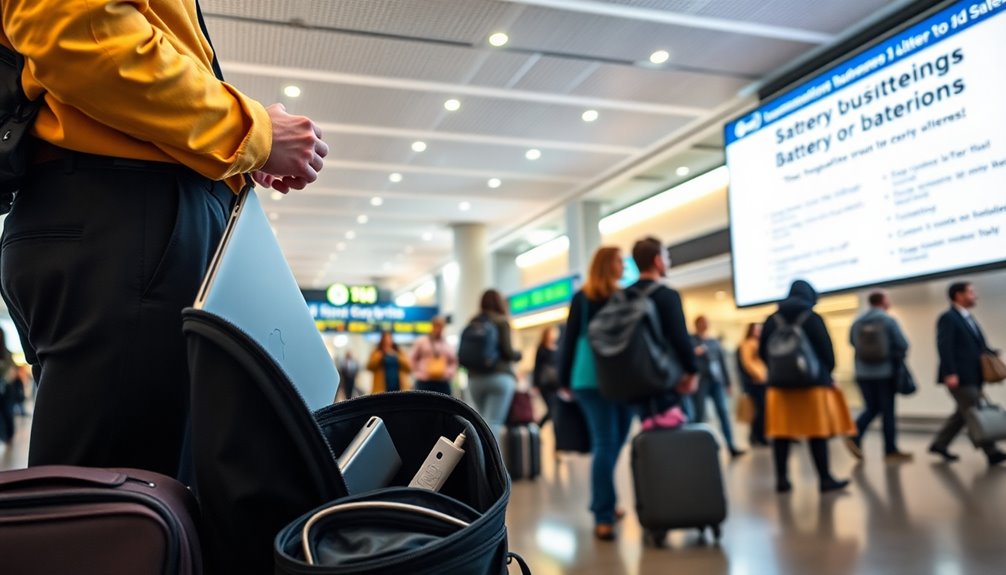
When you travel internationally with lithium batteries, it's important to check the specific regulations for each country you're visiting.
Different countries and airlines may have unique policies that could affect your packing and transport.
Staying informed about these rules will help you avoid fines and guarantee a smooth journey.
Country-Specific Regulations
As you prepare for international travel, understanding country-specific regulations for lithium batteries is essential to avoid complications at the airport.
Many countries follow IATA standards, but some have stricter rules for battery transport. Consider the following:
- In the European Union, lithium battery devices must be in hand luggage.
- Japan and South Korea have rigorous checks for batteries in checked baggage.
- Non-compliance can lead to fines or confiscation.
Always verify regulations for your destination and familiarize yourself with airline-specific policies, as these can vary widely.
Ensuring compliance with travel safety guidelines will help make your air travel smooth and worry-free.
Airline Policies and Procedures
Understanding airline policies and procedures regarding lithium batteries is key to ensuring a hassle-free journey.
Most airlines require you to transport lithium batteries in your carry-on luggage, as checked baggage for spare batteries is prohibited due to the risk of fire.
Regulations set by the International Air Transport Association (IATA) may guide international travel, but you should verify specific country rules, as some may impose stricter guidelines.
You can carry batteries under 100 watt-hours without prior approval, while those between 100-160 watt-hours need explicit permission.
Additionally, some airlines limit spare batteries, allowing only two to four, depending on their wattage.
Compliance with airline policies regarding damaged or recalled batteries is essential to avoid penalties or denial of boarding.
Handling Device Incidents

If a device with a lithium-ion battery is accidentally dropped during a flight, it's vital to remain calm and let the cabin crew handle the situation.
Attempting to retrieve it yourself can damage the battery and increase the fire risk. Instead, follow these steps:
- Stay seated and keep your seatbelt fastened.
- Notify cabin crew immediately if you notice signs of thermal runaway, like excessive heat or smoke.
- Trust the trained crew to safely retrieve the device.
Safety measures are in place to protect passengers from potential hazards linked to lithium-ion batteries.
Best Practices for Battery Safety

To guarantee your safety when traveling with lithium batteries, always carry them in your carry-on luggage instead of checked baggage, as this significantly reduces fire risks.
Before you travel, inspect all devices and batteries for signs of damage or overheating, confirming they're powered off during takeoff and landing.
Store loose lithium-ion batteries in protective cases or plastic bags to prevent short circuits and avoid contact with metal objects.
Use original packaging or secure pouches for spare batteries during transport, and tape battery terminals to prevent accidental activation.
Familiarize yourself with airline-specific regulations, including wattage limits and restrictions on spare batteries, to confirm compliance and a smooth experience during security checks.
Safe travels!
Frequently Asked Questions
Can I Fly With Lithium Batteries in My Carry-On?
Yes, you can fly with lithium batteries in your carry-on.
Just make certain your devices are powered off during takeoff and landing, and avoid charging them while onboard.
If you've got spare lithium batteries, keep them in protective cases or plastic bags to prevent short circuits.
Check the watt-hour rating; anything over 100 watt-hours needs airline approval.
Always inspect your devices for damage before your flight to guarantee a safe journey.
What Is the New Rule for Lithium Batteries?
The new rule for lithium batteries states you must carry spare lithium batteries in your carry-on luggage only.
They're banned from checked bags to reduce fire risks.
If you've devices with lithium-ion batteries, like your laptop or smartphone, you can pack them in both carry-on and checked baggage, as long as they're turned off.
For loose batteries, make sure they're in protective cases to prevent short circuits while traveling.
Why Does TSA Ask if You Have Lithium Batteries?
The TSA asks if you've got lithium batteries to guarantee everyone's safety during flights.
These batteries can pose a fire risk, especially if they're over 100 watt-hours. By checking, the TSA helps prevent issues like thermal runaway, which can lead to uncontrollable fires.
They also want you to pack spare batteries in your carry-on and keep them protected from short circuits, making the flying experience safer for all passengers.
Which Type of Lithium Batteries Are Forbidden to Transport by Passenger Air?
When it comes to lithium batteries, think of them like fireflies—bright but potentially dangerous.
You can't transport damaged, defective, or recalled lithium batteries by passenger air, as they can spark trouble mid-flight. Additionally, batteries with a watt-hour rating over 160Wh often require special permission; some airlines mightn't even allow them at all.
Always check their status before packing to guarantee a safe journey for everyone onboard.
Conclusion
In conclusion, staying informed about lithium battery regulations is essential for safe travel. Imagine boarding a plane when suddenly an unattended bag starts to smoke—panic can spread quickly. By following the guidelines for carry-on and checked luggage, and knowing how to pack safely, you can help prevent incidents like this. Always prioritize battery safety during your travels, ensuring a worry-free journey for yourself and everyone on board. Your vigilance can make a significant difference.

